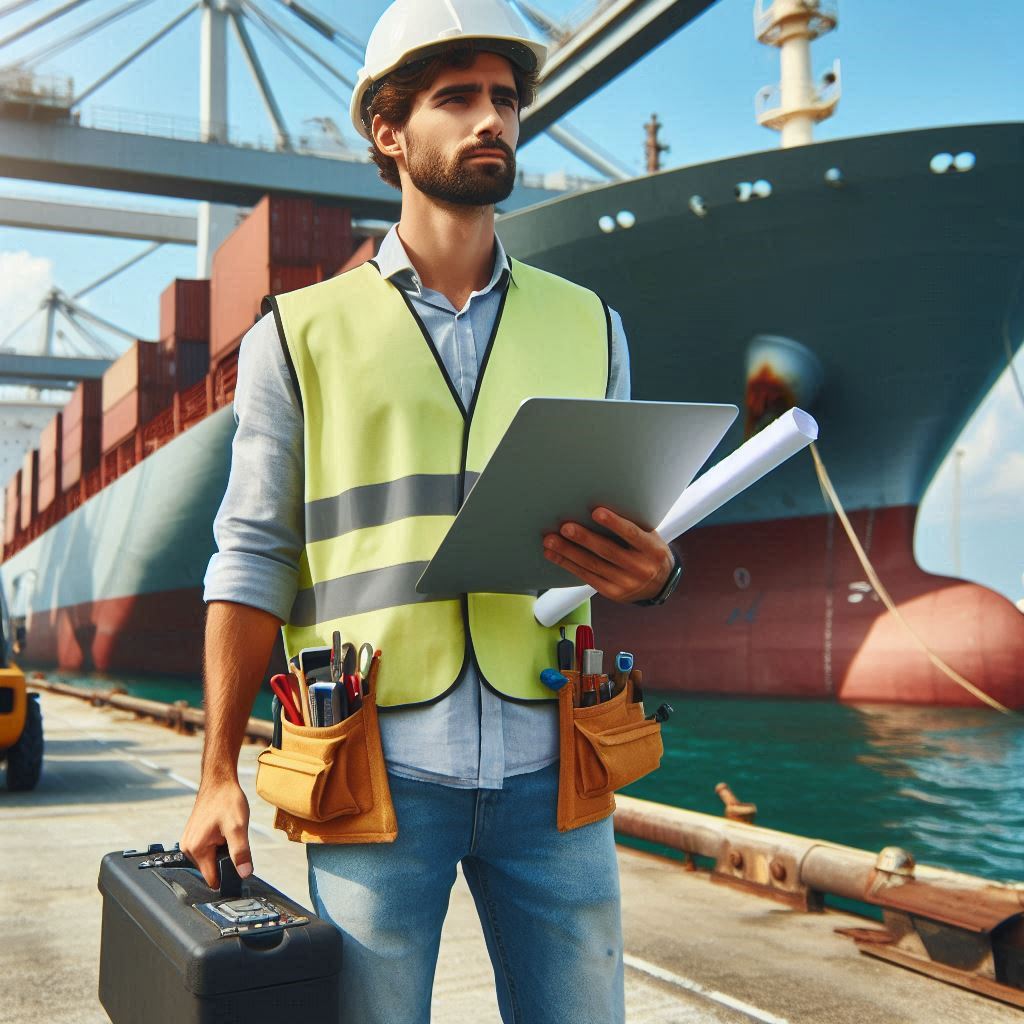Introduction
Marine engineers play a crucial role in both the design and maintenance of ships.
They are responsible for ensuring the safety and efficiency of maritime vessels.
From the initial concept stage to the final construction, marine engineers collaborate with naval architects and other professionals to design a ship that meets performance, safety, and environmental standards.
In the maintenance phase, marine engineers conduct regular inspections, repairs, and upgrades to ensure that the ship continues to operate at peak performance.
Their expertise is essential in identifying and resolving potential issues to prevent accidents and minimize downtime, ultimately contributing to the overall success of the maritime industry.
With advancements in technology and regulations, marine engineers must stay up-to-date with the latest trends and developments to continue improving ship design and maintenance practices.
Generally, marine engineers are indispensable in the maritime sector, playing a vital role in shaping the future of ship design and maintenance for safer and more efficient operations.
Educational requirements for becoming a marine engineer
The Necessary Qualifications
To become a marine engineer, a degree in marine engineering or a related field is essential.
This degree provides foundational knowledge in ship design, propulsion systems, and maintenance practices.
Students study subjects like fluid dynamics, thermodynamics, and mechanical and electrical engineering principles.
Courses in naval architecture offer insights into the structural design of ships, preparing students to tackle engineering challenges.
Marine engineering programs also include materials science, which is crucial for selecting appropriate materials for ship construction and repair.
This knowledge helps ensure that ships are built to withstand harsh marine environments.
Additionally, students learn about marine safety regulations and environmental considerations, which are important for ensuring that ships meet industry standards.
Importance of Hands-On Experience and Practical Training
Hands-on experience is critical for aspiring marine engineers.
Practical training through internships or co-op programs provides real-world exposure to ship design and maintenance.
This experience allows students to apply theoretical knowledge in practical settings, enhancing their problem-solving skills and familiarity with industry practices.
Marine engineering programs often include laboratory work and simulation exercises.
These activities simulate real-life scenarios, helping students develop practical skills in operating and troubleshooting ship systems.
Such hands-on experience is invaluable for understanding the complexities of ship systems and maintenance procedures.
Working directly in shipyards or aboard vessels offers additional practical training.
This exposure helps engineers gain insights into the operational challenges and maintenance needs of ships.
It also enhances their ability to diagnose and resolve issues that arise in real-world situations.
Practical experience ensures that marine engineers are well-prepared for their professional roles.
It complements the theoretical knowledge gained through formal education and equips engineers with the skills needed to handle the diverse challenges in ship design and maintenance.
Overall, a combination of relevant academic qualifications and hands-on experience is essential for a successful career in marine engineering.
This blend of education and practical training prepares marine engineers to design and maintain ships effectively, ensuring that vessels are safe, efficient, and capable of performing their intended functions.
Role of marine engineers in ship design
How Marine Engineers Collaborate with Naval Architects to Design Vessels That Meet Safety Regulations and Performance Standards
Marine engineers play a crucial role in ship design by collaborating closely with naval architects.
This partnership ensures that vessels meet all safety regulations and performance standards.
Marine engineers provide essential expertise on mechanical systems, while naval architects focus on the overall vessel design.
Together, they evaluate design plans to ensure that every aspect of the ship adheres to safety regulations.
Marine engineers contribute by assessing the feasibility of various systems and technologies.
They help identify potential issues and suggest improvements to enhance safety and performance.
This collaboration involves constant communication and coordination throughout the design process.
Engineers and architects work together to address any design challenges and ensure that the vessel meets all required standards.
Their joint efforts result in ships that are both functional and reliable.
Importance of Considering Factors Like Stability, Propulsion Systems, and Fuel Efficiency in the Design Process
When designing a vessel, marine engineers focus on several critical factors, including stability, propulsion systems, and fuel efficiency.
Each of these elements plays a vital role in ensuring the ship’s overall performance and safety.
Stability is essential for preventing accidents and ensuring safe operation under various conditions.
Marine engineers analyze weight distribution and the center of gravity to maintain balance and stability.
Proper design in this area helps avoid capsizing and ensures the vessel can handle different sea states.
Propulsion systems are another key consideration.
Marine engineers select and design propulsion technologies to achieve optimal performance and efficiency.
They evaluate different engines and propulsion mechanisms to ensure that the vessel operates effectively and meets speed and maneuverability requirements.
Fuel efficiency is increasingly important in modern ship design.
Marine engineers work to integrate technologies that reduce fuel consumption and lower operating costs.
They assess various fuel types and systems to find the most efficient solutions for the vessel’s needs, contributing to overall operational efficiency.
Throughout the design phase, marine engineers conduct simulations and tests to predict the vessel’s performance.
These analyses help refine the design and address potential issues before construction begins.
Their focus on stability, propulsion, and fuel efficiency ensures that the vessel performs well and adheres to environmental regulations.
In summary, marine engineers collaborate with naval architects to design vessels that meet safety and performance standards.
By focusing on stability, propulsion systems, and fuel efficiency, they ensure that ships are safe, efficient, and effective.
This detailed approach to design is crucial for creating high-performing vessels that excel in various operational conditions.
Read: Sustainable Wastewater Treatment Methods
Responsibilities of marine engineers in ship maintenance
Overview of tasks involved in ship maintenance
Marine engineers play a crucial role in the maintenance and repair of various ship systems.
This includes engines, propulsion systems, and electrical systems, among others.
Let’s dive deeper into the specific responsibilities of marine engineers in ship maintenance.
Engine maintenance
One of the primary responsibilities of marine engineers is to inspect and maintain ship engines.
This involves conducting regular checks, servicing components, and addressing any issues that may arise.
Engine maintenance is essential to ensure that the ship operates efficiently and safely.
Propulsion system servicing
Marine engineers are also responsible for servicing propulsion systems on ships.
These systems are critical for the movement of the vessel, so it is crucial to keep them in good working condition.
Regular maintenance helps prevent breakdowns and ensures the safety of the crew and passengers onboard.
Electrical system testing and repair
In addition to engines and propulsion systems, marine engineers are tasked with testing and repairing electrical systems on ships.
These systems power essential components such as lights, navigation equipment, and communication systems.
Regular maintenance is necessary to prevent electrical malfunctions that could compromise the safety of the ship.
Importance of regular maintenance in ship systems
Maintaining ship systems is crucial for various reasons, including preventing breakdowns and ensuring the safety of the crew and passengers.
Let’s delve into the importance of regular maintenance in ship systems.
Preventing breakdowns
Regular maintenance helps identify potential issues in ship systems before they escalate into major breakdowns.
By conducting routine inspections and servicing components, marine engineers can address minor problems early on, preventing costly repairs and downtime.
Ensuring safety of crew and passengers
One of the primary reasons for regular maintenance in ship systems is to ensure the safety of the crew and passengers onboard.
Well-maintained systems are less likely to fail unexpectedly, reducing the risk of accidents at sea.
This is especially important for long voyages and in challenging weather conditions.
Basically, marine engineers play a critical role in ship maintenance by inspecting, repairing, and servicing various systems onboard.
Regular maintenance is essential to prevent breakdowns, ensure the safety of the crew and passengers, and maintain the overall efficiency of the vessel.
By fulfilling their responsibilities diligently, marine engineers contribute to the smooth operation and longevity of ships at sea.
Read: Tips for Writing Environmental Engineering Reports
Challenges Faced by Marine Engineers in Ship Design and Maintenance
Examination of Common Challenges
Marine engineers encounter several challenges in ship design and maintenance.
One major issue is working in harsh environmental conditions.
Ships operate in extreme weather, exposing them to saltwater corrosion, high winds, and rough seas.
Engineers must ensure that their designs can withstand these forces to maintain safety and performance.
Another significant challenge is managing complex systems.
Modern ships feature intricate machinery, electronics, and propulsion systems.
Engineers need to understand and integrate these systems seamlessly.
A failure in one component can affect the entire vessel’s functionality, demanding precise design and maintenance.
Maintenance presents additional hurdles.
Ships often undergo long voyages, requiring systems that are both durable and easy to repair.
Engineers must balance the need for reliability with the requirement for occasional servicing, making it crucial to design components that endure extended use.
Transform Your Career Today
Unlock a personalized career strategy that drives real results. Get tailored advice and a roadmap designed just for you.
Start NowHow Marine Engineers Overcome These Challenges
To address harsh conditions, marine engineers utilize advanced materials and innovative designs.
They use corrosion-resistant coatings and robust structural elements to protect ships from the elements.
These materials help extend the lifespan of the vessel and reduce maintenance needs.
Complex systems are managed through careful planning and integration.
Engineers collaborate with naval architects and shipbuilders to ensure all systems work harmoniously.
They use simulation tools to predict how materials and designs will perform under real-world conditions, allowing for adjustments before implementation.
Teamwork is vital in overcoming these challenges.
Engineers work closely with other professionals to address problems and develop solutions.
Regular coordination ensures that all aspects of the ship’s design and maintenance are well-aligned, contributing to the overall success of the project.
Innovative solutions also play a crucial role.
Engineers develop preventative maintenance plans to minimize the likelihood of breakdowns.
These plans involve routine inspections and timely component replacements, helping to prevent issues before they become critical.
Continued professional development is essential for marine engineers.
Ongoing training helps them stay updated with the latest technologies and methods.
This continuous learning enables them to adapt to new challenges and integrate advancements effectively.
In summary, marine engineers face challenges such as harsh environmental conditions and complex systems in ship design and maintenance.
They overcome these hurdles through innovative solutions, teamwork, and ongoing professional development, ensuring the efficient and safe operation of modern vessels.
Read: Public Health and Environmental Engineering

Technological advancements impacting the role of marine engineers
How Advancements in Technology, Such as Automation and Digitalization, Are Changing the Way Marine Engineers Approach Ship Design and Maintenance
Technological advancements have dramatically transformed marine engineering.
Automation and digitalization are reshaping how marine engineers handle ship design and maintenance.
Automated systems now handle routine tasks, minimizing human error and improving efficiency.
These systems manage critical functions, such as engine operations and navigation, with high precision.
Digitalization introduces new possibilities with digital twins.
These virtual models allow marine engineers to simulate and analyze ship performance before construction.
This proactive approach helps in identifying and resolving potential issues early, leading to more efficient and effective designs.
Furthermore, digital tools have enhanced data collection and analysis.
Marine engineers use sensors and IoT devices to monitor ship systems in real time.
This data-driven approach enables predictive maintenance, which prevents unexpected failures by addressing issues before they escalate.
Examples of New Tools and Software Used by Marine Engineers to Improve Efficiency and Accuracy
Several new tools and software have emerged, significantly improving marine engineering practices.
Computer-aided design (CAD) software is now essential for creating precise ship designs.
Engineers use CAD to develop detailed models and conduct virtual tests, optimizing ship structures and systems.
Predictive maintenance tools leverage advanced sensors and data analytics.
These tools monitor various ship components and predict maintenance needs.
For example, vibration analysis software detects early signs of wear in machinery, allowing for timely interventions.
The integration of Internet of Things (IoT) devices provides real-time monitoring capabilities.
IoT sensors gather data on ship performance and operational conditions, which is analyzed to optimize efficiency and prevent breakdowns.
This continuous feedback loop enhances the reliability of ship systems.
Virtual reality (VR) and augmented reality (AR) are revolutionizing training and maintenance.
VR simulations offer immersive training experiences, while AR provides overlay information on physical components during maintenance tasks.
These technologies improve training outcomes and operational efficiency.
Simulation software is another critical advancement.
It allows marine engineers to test various design scenarios and assess their impact on ship performance.
This helps in making informed design decisions and enhancing overall functionality.
Innovations in materials science have also played a role.
New materials with enhanced durability and efficiency contribute to better ship performance and longevity.
Marine engineers select these materials based on their properties to ensure optimal ship safety and functionality.
Most importantly, technological advancements such as automation and digitalization are significantly changing marine engineering.
New tools and software improve the efficiency and accuracy of ship design and maintenance, allowing marine engineers to work more effectively and enhance vessel performance.
Read: Environmental Engineering and Marine Conservation
Importance of Communication and Collaboration in the Field of Marine Engineering
The Need for Effective Communication Between Marine Engineers, Naval Architects, and Other Professionals Involved in Ship Design and Maintenance
Effective communication is crucial in marine engineering.
Marine engineers must interact with naval architects, designers, and other professionals throughout ship design and maintenance.
Clear communication helps align technical requirements with design goals.
Marine engineers provide insights on propulsion systems, which influence hull design and vessel performance.
This dialogue ensures that all components function together seamlessly, meeting operational and safety standards.
During construction, engineers and shipbuilders must coordinate closely.
They address design changes and unforeseen issues together, ensuring timely resolution.
Effective communication reduces the risk of errors and misalignments, contributing to a smoother construction process.
In maintenance, marine engineers must work with maintenance teams to schedule repairs and minimize vessel downtime.
This coordination is essential for maintaining operational efficiency.
Examples of Successful Collaboration Leading to Innovative Solutions and Improved Vessel Performance
Successful collaboration often leads to significant innovations.
One example is the development of hybrid propulsion systems.
Marine engineers and naval architects collaborated to integrate traditional engines with batteries, enhancing fuel efficiency and reducing emissions.
This innovation represents a major leap forward in sustainable shipping technology.
Another notable example involves advanced hull coatings.
Marine engineers worked with materials scientists to develop coatings that reduce drag and improve fuel efficiency.
This teamwork resulted in better performance and cost savings for modern vessels.
The use of these advanced coatings demonstrates how effective collaboration can lead to practical and impactful solutions.
The development of autonomous ships showcases the power of interdisciplinary collaboration.
Marine engineers, software developers, and robotics experts combined their expertise to create advanced systems that enhance navigation and safety.
This collaborative effort resulted in the successful deployment of autonomous vessels, showcasing improved efficiency and safety features.
These examples highlight the importance of communication and collaboration in marine engineering.
By working together, professionals can overcome challenges and achieve innovative solutions that significantly improve vessel performance.
Effective teamwork ensures that ship design and maintenance processes are executed efficiently and effectively, leading to better outcomes in the maritime industry.
Conclusion
Marine engineers are integral to ship design and maintenance.
They ensure vessels operate efficiently and safely.
Their work begins in the design phase, where they collaborate with naval architects.
They design propulsion systems, power generation units, and other essential machinery.
Marine engineers also select materials that withstand harsh marine environments.
During construction, marine engineers oversee installation processes.
They ensure machinery aligns with design specifications and meets safety standards.
Regular maintenance is another crucial aspect of their role.
Marine engineers perform inspections, repairs, and upgrades to keep ships in optimal condition.
Their expertise is vital in preventing mechanical failures and ensuring regulatory compliance.
Marine engineers address issues before they escalate, minimizing downtime and operational disruptions.
They also adapt to advancements in technology, integrating new systems into existing designs.
Looking to the future, marine engineering faces several challenges.
The industry is moving towards greener technologies and more efficient designs.
Marine engineers must stay updated with environmental regulations and sustainable practices.
Innovations in automation and digital systems will also impact their roles.
[E-Books for Sale]
The Big Book of 500 High-Paying Jobs in America: Unlock Your Earning Potential
$19.99 • 500 High-Paying Jobs • 330 pages
Explore 500 high-paying jobs in America and learn how to boost your career, earn more, and achieve success!
See All 500 High-Paying Jobs of this E-Book
1001 Professions Without a Degree: High-Paying American Jobs You Can Start Now
$19.99 • 1001 Professions Without a Degree • 174 pages
Discover 1001 high-paying jobs without a degree! Unlock career tips, skills, and success strategies for just $19.99!




